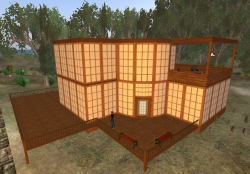
I was thinking while building in SL the other day (from a new builder perspective) that there were so many possibilities that you're only limited by your imagination and space (prim limit). And even that's not necessarily true, if your willing take your learning outside the realm of SL. There are a multitude of programs, free for use, that can expand what you can do, from building objects, clothing, or animation. But from my new builder perspective, it can be a lot to observe all at once. So I decided to start small and simpler as I was working on the daycare center. In one such case, I was working on the play area inside the center, and I thought to myself can I build toys? How much work would it take to do so, and if so what would I build? I chose for my first toy, the ol' ring stack, both because it would employ many colors and require specific sized objects (prims) to make it look correct. I got so excited with my relative success that I went on to build a little climbing area and put some balls on the shelves.

Another fascination I came across early in my experience in SL was the interactive objects you can incorporate in to your environment. This includes sights and sounds specific to your location, music, powerpoints, and even live TV. As shown to the left, I built a small TV viewing area that could be programmed to stream children friendly programming while the day care is in operation. There are other possibilities with SL as well, in that you can have actual voice chat so that you can speak with participants, tell stories during reading hours, or coordinate sing-a-longs and dancing. The fact that SL allows for a fully functioning environment, I hope, will lead to a successful day care center where students can learn about real pitfalls, foibles, mistakes, and hone their skills into real life action.
 I was thinking while building in SL the other day (from a new builder perspective) that there were so many possibilities that you're only limited by your imagination and space (prim limit). And even that's not necessarily true, if your willing take your learning outside the realm of SL. There are a multitude of programs, free for use, that can expand what you can do, from building objects, clothing, or animation. But from my new builder perspective, it can be a lot to observe all at once. So I decided to start small and simpler as I was working on the daycare center. In one such case, I was working on the play area inside the center, and I thought to myself can I build toys? How much work would it take to do so, and if so what would I build? I chose for my first toy, the ol' ring stack, both because it would employ many colors and require specific sized objects (prims) to make it look correct. I got so excited with my relative success that I went on to build a little climbing area and put some balls on the shelves.
I was thinking while building in SL the other day (from a new builder perspective) that there were so many possibilities that you're only limited by your imagination and space (prim limit). And even that's not necessarily true, if your willing take your learning outside the realm of SL. There are a multitude of programs, free for use, that can expand what you can do, from building objects, clothing, or animation. But from my new builder perspective, it can be a lot to observe all at once. So I decided to start small and simpler as I was working on the daycare center. In one such case, I was working on the play area inside the center, and I thought to myself can I build toys? How much work would it take to do so, and if so what would I build? I chose for my first toy, the ol' ring stack, both because it would employ many colors and require specific sized objects (prims) to make it look correct. I got so excited with my relative success that I went on to build a little climbing area and put some balls on the shelves.  Another fascination I came across early in my experience in SL was the interactive objects you can incorporate in to your environment. This includes sights and sounds specific to your location, music, powerpoints, and even live TV. As shown to the left, I built a small TV viewing area that could be programmed to stream children friendly programming while the day care is in operation. There are other possibilities with SL as well, in that you can have actual voice chat so that you can speak with participants, tell stories during reading hours, or coordinate sing-a-longs and dancing. The fact that SL allows for a fully functioning environment, I hope, will lead to a successful day care center where students can learn about real pitfalls, foibles, mistakes, and hone their skills into real life action.
Another fascination I came across early in my experience in SL was the interactive objects you can incorporate in to your environment. This includes sights and sounds specific to your location, music, powerpoints, and even live TV. As shown to the left, I built a small TV viewing area that could be programmed to stream children friendly programming while the day care is in operation. There are other possibilities with SL as well, in that you can have actual voice chat so that you can speak with participants, tell stories during reading hours, or coordinate sing-a-longs and dancing. The fact that SL allows for a fully functioning environment, I hope, will lead to a successful day care center where students can learn about real pitfalls, foibles, mistakes, and hone their skills into real life action.














